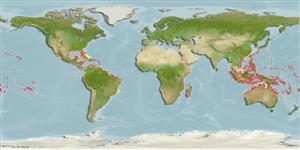Gastropoda |
Littorinimorpha |
Ranellidae | Cymatiinae
Environment: milieu / climate zone / εύρος βάθους / distribution range
Οικολογία
; εύρος βάθους 0 - 27 m (Αναφ. 83435). Tropical; 32°N - 26°S, 97°E - 48°E (Αναφ. 83435)
Indo-Pacific and Western Atlantic.
Length at first maturity / Μέγεθος / Weight / Age
Γεννητική Ωρίμανση: Lm ? range ? - ? cm Max length : 7.5 cm SHL αρσενικό/απροσδιόριστο; (Αναφ. 349); common length : 5.0 cm SHL αρσενικό/απροσδιόριστο; (Αναφ. 349)
Very common in shallow waters (Ref. 349). Found in muddy sand (Ref. 799) and sandy to coarse detritic coral bottoms (Ref. 349). Also found on sandy lagoon floors, lagoon shelves, fringing reefs and rocks from the low tide line. Reported near seagrass bed and in algal turf (Ref. 69146). On seagrass (Ref. 109264).
Life cycle and mating behavior
Γεννητική Ωρίμανση | Αναπαραγωγή | Γεννοβολία | Eggs | Γονιμότητα | Larvae
Members of the order Neotaenioglossa are mostly gonochoric and broadcast spawners. Life cycle: Embryos develop into planktonic trocophore larvae and later into juvenile veligers before becoming fully grown adults.
Poutiers, J.M. 1998 Gastropods. p. 363-648. In Carpenter, K. E. and V. H. Niem. 1998. FAO species identification guide for fishery purposes. The living marine resources of the Western Central Pacific. Volume 1. Seaweeds, corals, bivalves, and gastropods. Rome, FAO. (Αναφ. 349)
IUCN Red List Status
(Αναφ. 130435: Version 2025-1)
CITES status (Αναφ. 108899)
Not Evaluated
Not Evaluated
Threat to humans
Human uses
| FishSource |
Εργαλεία
Περισσότερες πληροφορίες
Population dynamicsΑύξησηMax. ages / sizesLength-weight rel.Length-length rel.Length-frequenciesMass conversionΑφθονία Life cycleΑναπαραγωγήΓεννητική ΩρίμανσηΓονιμότηταΓεννοβολίαEggsEgg developmentLarvae PhysiologyΚατανάλωση οξυγόνου
Human RelatedStamps, coins, misc.
Διαδικτυακές πηγές
Estimates based on models
Preferred temperature
(Ref.
115969): 24.7 - 29.2, mean 28.2 (based on 3417 cells).
Fishing Vulnerability
Low vulnerability (10 of 100).
Price category
Unknown.
